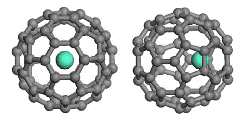Chemistry, Department of: Faculty Series

Xiao Cheng Zeng Publications
Document Type
Article
Date of this Version
4-1-2006
Abstract
We have performed unconstrained search for low-lying structures of medium-sized silicon clusters Si31–Si40 and Si45, by means of the minimum-hopping global optimization method coupled with a density-functional based tight-binding model of silicon. Subsequent geometric optimization by using density-functional theory with the PBE, BLYP, and B3LYP functionals was carried out to determine the relative stability of various candidate low-lying silicon clusters obtained from the unconstrained search. The low-lying characteristics of these clusters can be affirmed by comparing the binding energies per atom of these clusters with previously determined lowest-energy clusters (Sin) in the size range of 21≤n≤30. In view of the fact that there exist numerous low-lying “endohedral fullerenelike” isomers for each size in the range 30≤n≤40, we used the homologue carbon-fullerene cage to classify different families of isomers. This structural classification allows us to focus on generic features of various isomers and to group many apparently different isomers into a single family. In addition, we report a new family of low-lying clusters which have “Y-shaped three-arm” structures. Isomers in this “handmade” family can be energetically competitive as the endohedral fullerene isomers when the total energies are calculated with the BLYP or B3LYP functional.


Comments
Published by American Institute of Physics. J. Chem. Physics 124, 164311 2006. ©2006 American Institute of Physics. Permission to use. http://jcp.aip.org/.